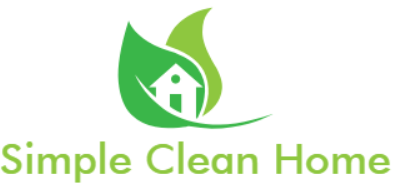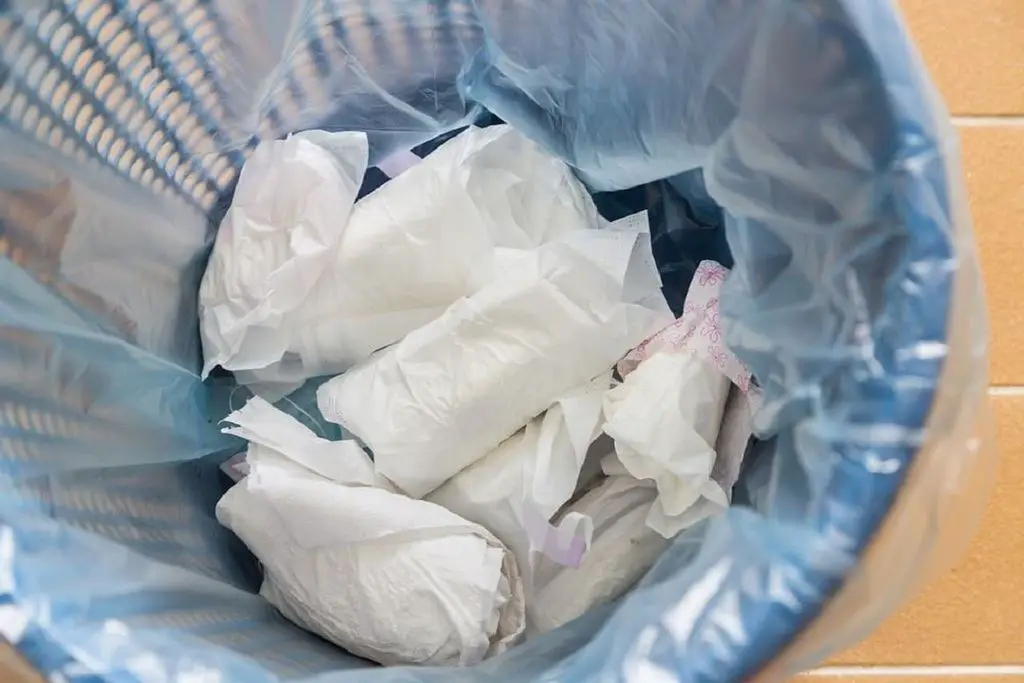How to Dispose of Diapers and Sanitary Pads: Stinky Secrets
There’s nothing worse than walking in the door and smelling diapers or sanitary pads in the trash, but how should you dispose of them to prevent that problem? Naturally, you need to seal in the smell, so it doesn’t permeate your home. In a pinch, you can always use grocery bags and double wrap each one individually, but that’s wasteful. Plus, it takes far too much time. Instead, I recommend sanitary product sealing garbage cans in the bathroom and nursery. These ingenious devices go by many names, but they all wrap up human waste. That keeps the smell where it belongs, in the can. After that, you merely take it out like regular trash, and you’re done with it. No more blood and poo smells in your home makes everything feel cleaner.
How do you dispose of diapers and sanitary pads? To dispose of diapers and sanitary pads, you need a sealed receptacle. Rather than taking out the trash ten times a day, it’s easier to get a good hygiene wastebasket that seals in odor. Luckily there are plenty of options available.
How to Dispose of Diapers and Sanitary Pads
The first step in the proper diaper and sanitary pad disposal is knowing that it smells far worse than you think. It’s easy to go nose-blind to scents you’re around all the time. It’s not your fault that you acclimate, but like a smoker, or someone with awful body odor, living with it makes it far less noticeable.
Busy modern life doesn’t always leave us the time we’d like to think about the little things. However, if you are seeking simple ways to have a cleaner, more pleasant home, you should always start where it smells the worst. That means trash and bathroom activities.
Diapers and pads are usually the worst offenders, but you can apply some of these tips to anything with a strong unpleasant smell.
First, a word of caution; Do not try to cover the smell with incense, heavy sprays, and plug-in perfumes. Like a teenager putting deodorant over stinky armpits, no one will fall for this trick, and it gives you two odor issues to handle.
A conveniently small Creative Baby Tidy Diaper Pail can help solve the issue of odors. At just twenty-two inches high and fifteen inches on the widest side, you can slide this well-sealed specialty garbage can in place of many bathroom trashcans. The modern design is easy to use and compatible with most trash bags. Moreover, it’s dishwasher safe for easy cleanup. Have one delivered when you order from Amazon right here.
The Emergency Only Method
This solution isn’t ideal, but it will help temporarily. You need extra plastic grocery bags and a container with a lid that seals. As each item, diaper or pad gets used, wrap it up. By recycling a grocery bag, you won’t need to buy extra Ziploc style bags just to throw them away.
I don’t suggest using this method for very long. Not only is it incredibly wasteful, but it’s also the least effective way to control the odor. Eventually, the scent will permeate the lidded container you’re using.
However, while you work on more permanent solutions, make sure you wash out your garbage and hygiene cans weekly. Using bleach works, but baking soda or white vinegar soaks will also help pull the odors out of plastic garbage cans.
Regrettably, metal garbage cans tend to get damaged over time when you wash them. The water eventually corrodes and rusts your can. Replace the stinky old aluminum buckets with a durable plastic instead. It will probably last longer and clean easier if you treat it right.
Method One: Outside Cans
The worst way to get rid of diapers and sanitary napkins is to dump them in an open garbage can. Even when you use scented bags, it does very little to prevent the smell. However, if that is your only option, then you can minimize the problem.
Although it’s extra work, taking the diaper bags to an outdoor trashcan that has a lid will help keep the smell out of your home. While I don’t recommend this method, it works when you have no alternatives available. Still, you should upgrade as soon as possible.
Outdoor cans are subject to rain and marauding animals. Moreover, they attract bugs who get curious about what’s inside. You can always build a sturdy, lockable cover for outdoor trash cans. It will not keep insects away, but at least raccoons, wild dogs, and bears won’t be able to hunt for snacks inside.
Method Two: Recycle
It may seem strange, but there is a company that recycles the plastics from diapers and sanitary pads. The British company Knowaste was one of the first of it’s kind to clean, sanitize, and recycle disposable diapers and sanitary pads. However, their idea has caught on. From Taiwan to California, new ways to clean and recycle these problem products are cropping up all over.
If there’s no diaper recycling in your area, then get proactive. Start a petition to your mayor or sanitation department. You don’t have to settle for sub-par options if you’re willing to make your voice heard.
Method Three: In the Meantime
Change doesn’t happen overnight. Most homes are on a budget now more than ever. Sure, start that petition today, but plan to wait a while and keep working on it before you get proper diaper recycling in your area. Don’t suffer while you wait.
Get a Playtex Diaper Genie from Amazon and solve the diaper-smell issue today. The best known, and trusted diaper disposal is still a smart choice for odor control. The built-in antimicrobials help prevent the spread of germs and bacteria. Check the ratings yourself when you click right here.
How Many Diapers & Sanitary Pads You Use
Disposing of diapers and sanitary pads might not seem like such a big deal if you can’t smell them, but there’s more to it than you might think. According to Parenting, the average baby uses two-hundred-forty to three-hundred-twenty diapers per month. That adds up to thousands in a year.
Sadly, while some trash is biodegradable, most disposable diapers are not on that list. It can take up to five hundred years for the plastics in a single diaper to decompose completely. In the meantime, it remains a contaminant sitting in a landfill.
Mothers and other women are using a staggering five to fifteen thousand sanitary pads apiece in their lifetime. The worse news is that those pads aren’t very hygienic, especially when thrown out. It all adds up to hundreds of thousands of tons of waste going into landfills.
In addition to disposing of your used hygiene products in more nose-friendly ways, I have an additional suggestion. Consider switching to a more eco-friendly product. Not only the diapers and pads but also the bags you place them inside take decades to break down.
You’ll still be breathing in, drinking, and eating the results of that trash even after it goes to a dump, and you can’t smell it anymore.
Diapers & Sanitary Pads You Don’t Throw Out
For those who care as much about the environment as they do about household smells, you don’t have to throw out diapers or pads. Instead, convert to the reusable variety. However, if you’re anything like me, then you’re probably skeptical. I’ll explain why it’s not as odd or gross as is sounds.
First, it almost goes without saying that waste reduction is an investment in your future. Moreover, it’s also a great way to save money. Cloth diapers and alternative feminine hygiene seems unusually messy to Americans because we’ve been trained for the wasteful convenience of plastics.
When you do it right, there’s a lot less mess and odor to worry about. The first thing you need to know is that you should never just toss fully saturated hygiene products in the wash. Whether they’re cotton pads or cloth diapers, you need to rinse first.
A high-quality diaper spray attachment for your toilet takes less than ten minutes to put in. Better yet, once you have one, all you need to do is rinse most of the mess into the toilet and flush. That will take care of half or more of the odor. So what do you do with the rest?
The answer is simple. Get a bucket. Any clean mop bucket will do, but I suggest using plastic instead of metals. You’re going to want to fill it about halfway with water and add some baking soda or white vinegar (not both). Then add a few drops of mild detergent like Dawn or a tablespoon of laundry soap and swirl it around to mix.
When you finish with a pad or diaper, rinse it. Add the damp, but mostly clean hygiene products to the bucket. When your bucket is full, dump the water out and wash the laundry.
A Different Solution for Women
Maybe you’re a heavy flow type, and the cloth pads simply won’t do for you. I have great news. You can still ditch the pads and tampons altogether. Women’s body care and period products have come a very long way in the last few decades.
I recommend every woman try the FLEX Menstrual Cup Starter Kit. It comes with a washable cup and disposable disks so you can test which option is more comfortable for you. If you haven’t seen these before, they are insertable, but unlike tampons, there’s no messy string. You’ll be surprised how comfortable and straightforward feminine hygiene can be. To learn more about Flex on Amazon, click here.
Final Thoughts
Diaper and sanitary pad waste do more than stink when you don’t dispose of them properly. It’s becoming a severe hazard for the planet. Fortunately, scientists and environmentalists are working on better solutions all the time.
You don’t want your house or the world to smell like human waste, and luckily it doesn’t have to. Make sure you properly package and dispose of used hygiene products. Your nose and your guests will thank you for it.
Keeping a clean home is hard enough without diaper and pad odors. Place some activated charcoal pouches, or baking soda at the bottom of your trashcans to help trap lingering nasty smells.

